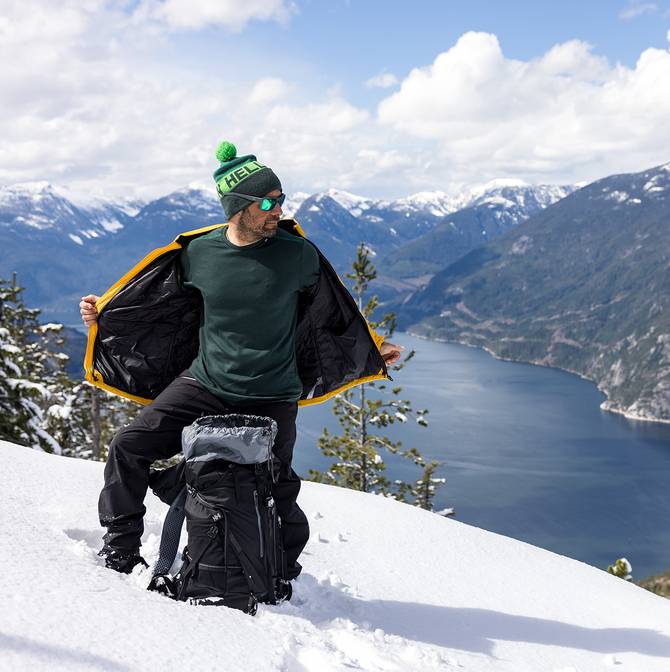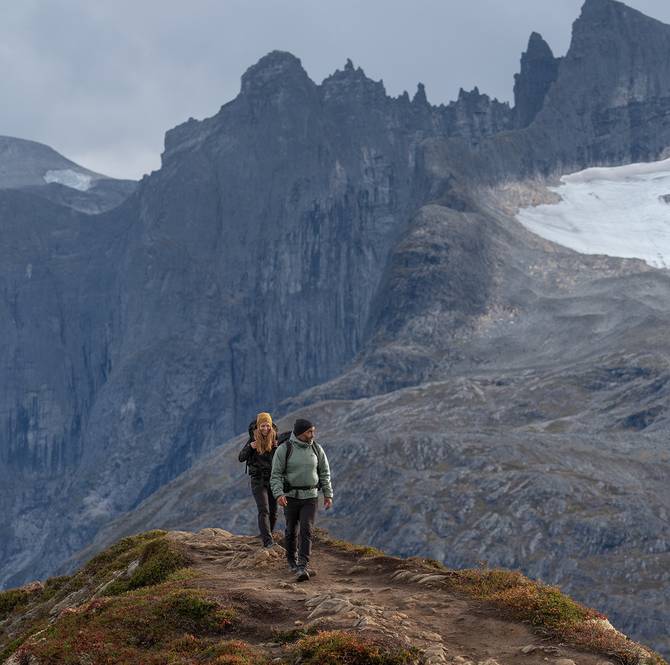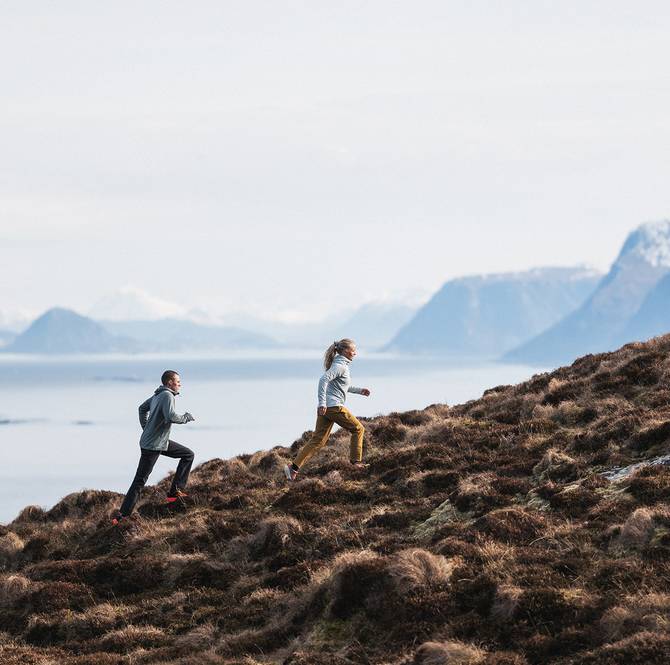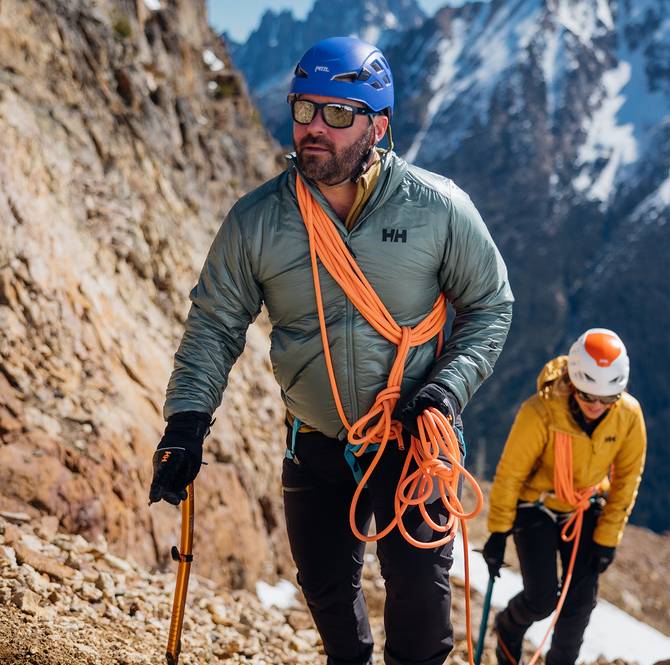The midlayer: your essential tool for conquering the outdoors. Whether you’re a warm-blooded skier pushing your limits or a hiker embracing the trails year-round, the right midlayer is key to staying comfortable and performing at your peak.
This guide will help you understand the purpose of midlayers, explore different materials, and select the best option tailored to your specific pursuits.
What is a Midlayer
A midlayer is the insulating component of the layering system, worn between the base layer and the outer shell. Its primary function is to retain body heat while allowing moisture to escape, keeping you warm and dry during physical activities.
Before choosing a midlayer, it’s essential to understand the three-layer system:
- Base Layer: Wicks moisture away from the skin, keeping you dry and comfortable. It also offers UV protection when worn on its own in warmer conditions.
- Midlayer: Provides essential insulation, trapping body heat while remaining breathable. Depending on activity level and temperature changes, it can be easily added or removed.
- Shell Jacket: The outermost layer, shielding you from wind, rain, sleet, and even sea spray. A quality shell ensures the elements don’t slow you down.
While the midlayer delivers warmth, the shell offers ultimate protection from the weather. Pairing the right midlayer with a well-designed shell ensures optimal performance and comfort, no matter the conditions.
Shop > Men’s Midlayers | Women’s Midlayers
Key Considerations When Choosing a Midlayer
- Activity intensity: Higher-intensity activities require more breathable midlayers.
- Weather conditions: Consider the temperature, wind, and potential for rain or snow.
- Fit and comfort: A snug fit is ideal for heat retention, but it still needs to allow for comfortable movement.
-
Midlayer weight:
- Lightweight: Best for high-intensity activities like running or climbing.
- Midweight: Versatile for most outdoor activities.
- Heavyweight: Provides maximum warmth for extreme cold.

Selecting the Right Midlayer for Your Activity
Best Midlayer for Skiing and Snowboarding
A synthetic or down midlayer is essential for skiing and snowboarding, providing warmth without the bulk to ensure unrestricted movement on the slopes. Down insulation is ideal for cold, dry conditions, while synthetic options like LIFALOFT™ offer lightweight warmth and moisture management, making them perfect for changing mountain conditions. Fleece is a breathable alternative for those who run warm, preventing overheating during high-energy descents.
HH Australia Staff Pick: “I love my LIFALOFT™ Insulator Jacket for weekend snowboarding at Kosciuszko, it’s surprisingly warm for something so light.” – Luke

Best Midlayer for Hiking
Hiking midlayers should balance warmth, breathability, and moisture control, especially during strenuous climbs and unpredictable weather. Fleece is a versatile option for maintaining warmth while allowing heat to escape, while synthetic insulation offers lightweight durability for multi-day treks. Merino wool provides natural warmth and odour resistance, making it an excellent choice for longer journeys.
HH Australia Staff Pick: “When I’m hiking in the Blue Mountains, the Varde Fleece 2.0 is my go-to midlayer. It’s light enough to keep me cool on the way up but still provides that extra warmth under my shell when the wind picks up at the lookouts.” – Ben

Best Midlayer for Sailing
Out on the water, your midlayer needs to handle wind, spray, and shifting temperatures. Synthetic insulation keeps you warm even if it gets damp, while merino wool naturally wicks moisture, making it a great choice for long days at sea.
HH Australia Staff Pick: “I’m obsessed with my HP Hybrid Stretch Insulator. I tend to run cold when sailing, I wore it during the Twilight Series race a few weeks back, and despite the rain, I was super warm while still able to move around easily.” – Georgia

Best Midlayer for Trail Running
When you’re pushing the pace on the trails, the last thing you want is to overheat or feel weighed down. A lightweight fleece keeps you warm without trapping too much heat, while a synthetic midlayer manages sweat and dries quickly. The right midlayer moves with you, keeping you comfortable whether you’re tackling steep climbs or cruising downhill.
HH Australia Staff Pick: “For trail running, I tend to grab my Versalite Fleece Jacket, it does what it says on the tin. It’s super versatile, keeps me warm, it’s breathable, and when the sun comes out, it packs up nicely into my running vest..” – Laura

Best Midlayer for Trekking
Trekking often means facing unpredictable weather, from chilly mornings to warm afternoons. A down midlayer packs away easily when you don’t need it, while synthetic insulation like LIFALOFT™ keeps you warm even if the weather turns. It’s all about having a midlayer that adapts with you so you’re ready for whatever the trail brings.
HH Australia Staff Pick: “I’m just back from a multi-day trek in New Zealand, and the Varde Fleece 2.0 was a welcome addition to my trekking gear. When the wind picked up, it kept me toasty, and the full zip made it easy to throw on and off.” – Justine

Best Midlayer for Climbing
Climbing demands a midlayer that keeps you warm without holding you back. A synthetic insulation layer delivers warmth without bulk, and a stretch fleece design ensures full mobility. Whether reaching for the next hold or belaying a partner, your midlayer should move with you while keeping you comfortable in ever-changing conditions.
HH Australia Staff Pick: “The mornings get pretty chilly when climbing at the Blue Mountains, so my Verglas Insulator Jacket is a must. It keeps me warm without feeling bulky, and the stretch makes it easy to move between holds.” – Adam

Understanding The Types of Midlayer Materials
Fleece Midlayers
Fleece is known for its softness and breathability. While not as technical as some other midlayers, fleece made with Polartec® technology is an excellent option for casual outdoor wear or as a lightweight insulation layer for mild conditions.
Benefits: Comfortable and soft, breathable and moisture-wicking, easy to care for.
Pile Midlayers
Pile fleece provides excellent warmth and breathability, making it a great choice for high-intensity activities. The open structure enhances ventilation, preventing overheating while keeping you warm.
Benefits: Highly breathable, great for high-energy activities, warm yet lightweight.
Down Midlayers
Down is highly regarded for its warmth-to-weight ratio, making it an excellent choice for cold and dry conditions. It compresses easily, making it ideal for activities where space is limited, like hiking or skiing.
Benefits: Exceptional warmth, lightweight and packable, ideal for cold and dry climates.
Synthetic Insulation
Synthetic midlayers, such as LIFA®, are designed to retain warmth while remaining lightweight and breathable. These are perfect for wet conditions, as synthetic fibres maintain their insulating properties even when damp.
Benefits: Retains warmth even when wet, lightweight and packable, quick-drying.
Merino Wool Midlayers
Merino wool is naturally insulating and odour-resistant, making it ideal for cold-weather activities. It retains heat even when wet and provides excellent comfort for long-duration wear.
Benefits: Odour-resistant, retains warmth even when damp, sustainable and natural.
Why Choose a Helly Hansen Midlayer
Helly Hansen has been developing professional-grade gear for over 140 years. With innovative technologies like HELLY TECH® and LIFALOFT™, you can be confident in your gear’s performance in any environment.
Explore Helly Hansen’s midlayers now >
FAQs
Is fleece or down a better midlayer?
Fleece is breathable and ideal for high-intensity activities, as it wicks moisture and dries quickly. Down offers superior warmth and is best for cold, dry conditions, but it loses insulation properties when wet.
Should the midlayer be tight or loose?
A midlayer should fit snugly enough to trap warmth without restricting movement. It should also allow for easy layering over a base layer and under a shell jacket.
Can you wear cotton as a midlayer?
No. Cotton absorbs moisture and dries slowly, making it unsuitable for outdoor activities. It can also lead to heat loss and discomfort in cold conditions.
What is the difference between the base layer and the midlayer?
The base layer wicks moisture away from your skin, keeping you dry, while the midlayer provides insulation to retain body heat.
What should your midlayer be made out of?
The best midlayer material depends on your activity: fleece for breathability, down for warmth, synthetic insulation for moisture resistance, and merino wool for a balance of warmth and odour resistance.
Can you wear a midlayer on its own?
Yes, a midlayer can function as an outer layer in mild conditions. However, in harsh weather, it’s best worn under a waterproof and windproof shell.
How do I care for my midlayer?
Care depends on the material. Down midlayers require specialised detergent and careful drying, while fleece and synthetics can typically be machine-washed. Always check the care label for the best results.


